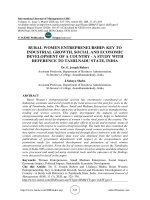Economic growth and economic development 290
Bạn đang xem bản rút gọn của tài liệu. Xem và tải ngay bản đầy đủ của tài liệu tại đây (131.59 KB, 1 trang )
Introduction to Modern Economic Growth
Let xt+1 = (x∗ (t + 1) , x (t + 2) , ...) ∈ Φ (x∗ (t + 1)) be any feasible plan starting
with x∗ (t + 1). By definition, xt = (x∗ (t) , xt+1 ) ∈ Φ (x∗ (t)). Since V ∗ (x∗ (t)) is
the supremum starting with x∗ (t), we have
¯ t)
V ∗ (x∗ (t)) ≥ U(x
¯ t+1 ).
= U(x∗ (t) , x∗ (t + 1)) + β U(x
Combining this inequality with (6.14), we obtain
¯ ∗t+1 ) ≥ U(x
¯ t+1 )
V ∗ (x∗ (t + 1)) = U(x
for all xt+1 ∈ Φ (x∗ (t + 1)). This establishes that x∗t+1 attains the supremum start-
ing from x∗ (t + 1) and completes the induction step, proving that equation (6.13)
holds for all t ≥ 0.
Equation (6.13) then implies that
¯ ∗t )
V ∗ (x∗ (t)) = U(x
¯ ∗t+1 )
= U(x∗ (t) , x∗ (t + 1)) + β U(x
= U(x∗ (t) , x∗ (t + 1)) + βV ∗ (x∗ (t + 1)) ,
establishing (6.3) and thus completing the proof of the first part of the theorem.
Now suppose that (6.3) holds for x∗ ∈ Φ (x (0)). Then substituting repeatedly
for x∗ , we obtain
V ∗ (x (0)) =
n
X
β t U (x∗ (t) , x∗ (t + 1)) + β n+1 V ∗ (x (n + 1)) .
t=0
In view of the fact that V ∗ (·) is bounded, we have that
¯ ∗) =
U(x
lim
n→∞
∗
n
X
β t U (x∗ (t) , x∗ (t + 1))
t=0
= V (x (0)) ,
thus x∗ attains the optimal value in Problem A1, completing the proof of the second
part of the theorem.
Ô
We have therefore established that under Assumptions 6.1 and 6.2, we can freely
interchange Problems A1 and A2. Our next task is to prove that a policy achieving
the optimal path exists for both problems. We will provide two alternative proofs
276









